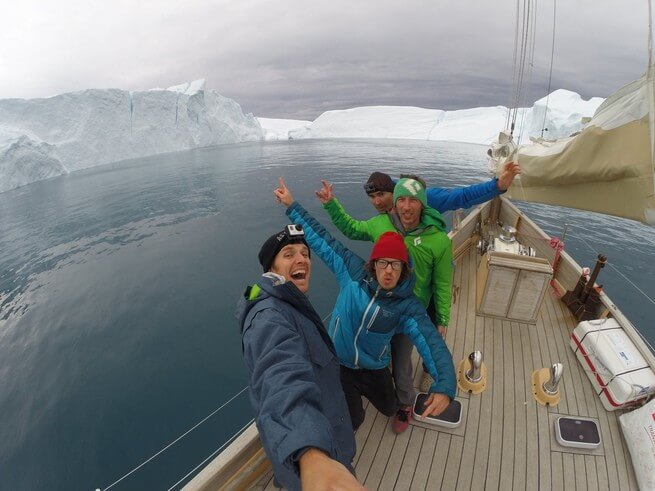How GoPro Drives Conversions Through Their Content
Content marketing has absolutely changed the way businesses try to market themselves to potential customers. However, a large amount of inbound marketing efforts seem to lose sight of the eventual goal of all marketing—conversions. Without having actual conversions as a result of your content, then you are throwing your money away. Fortunately, if this is something your brand is struggling with, you have places to look for examples of how to make it happen. Among these, none do it better than GoPro.

Image source: fr.gopro.com
Content That People Actually Want to See
GoPro doesn’t just do inbound marketing, they have taken it on as their identity. They release new videos or photos on their YouTube channel and across various social media platforms every single day, capturing a wide variety of subjects. The beauty of this content is how minimally advertorial it is while still being demonstrating the abilities of their product. Instead of spending time telling viewers they should go buy one of their cameras, they show them by demonstrating the GoPro cameras’ capabilities.
These videos keep branding minimal with GoPro’s logo and camera appearing at the beginning and end, but the majority of the video being dedicated to non-branded content. This strategy has been made even more effective by GoPro’s forward thinking by being an early adopter of Instagram, and using it to spread their content out through channels that other businesses had not yet utilized.
Giving people something they would actually want to see is where GoPro’s inbound marketing is especially effective. Though a great deal of their videos focus on action sports or daredevil activities, they have videos covering a wide range of interests their customers may have. This is especially important when trying to use content marketing to directly lead to conversions. A wide range of people may be interested in watching videos of amazing athletes doing risky things, but if they only produced this kind of content, they would be limiting their customer base. Many people would be impressed by the video, but not see a practical need to buy a camera themselves. Instead, GoPro also produces content featuring more daily life activities.
Maybe you don’t hang glide, but do you have a dog? Or love cute cat videos? Regardless of what you are interested in, GoPro has almost certainly created content that markets their products to you by showing how you could use one in your life, and they are working.

Image source: shop.gopro.com
Obviously, not all products lend themselves so naturally to inbound content creation. This is an advantage very specific to what GoPro does. However, there are still many lessons that other brands can learn from GoPro. Ask yourself why someone would want to purchase your product. Is there a unique thing that you can do that your customers cannot? Can it somehow make your customers’ lives better? These are trickier questions for some brands than others, but it’s vital to do if you want to emulate GoPro’s strategies and success.
Show, Don’t Tell
Once you identify answers to these, the real hard part begins; you need to figure out how to show, not tell. It’s easy to say that your product has features that potential customers would be interested in, but actually showing this through your content is a much more powerful way to utilize your content to drive conversions. If your product can save customers’ time, or solve a common problem they may have, use your content to represent this in a visual way.
Even better, if your product can do something cool, or visually appealing (like GoPro), show that. If you are able to make a pitch for someone to spend their money on your product without it feeling or sounding like a pitch, then you are much more likely to convert sales from your content. Frequently, GoPro doesn’t even have an explicit sales pitch of any kind in their content, because they have faith that their content will do the job of making their target audience interested in their product, and they will then seek out more information about it.
By putting out content with helpful information or that displays the potential of products within a niche, you also establish your brand as a trusted source of expertise within that field. As stated by Jeanine Guidry in a webinar for George Washington University’s Online Public Relations program,
“It’s very tempting for us to post things about our organization, our business, ‘Look at this new product. See what we’re doing here. Join us for this’. But if you balance that with information in your field that doesn’t directly promote what you’re doing but that is related to it, you first of all profile yourself as an expert in the area and you gain trust from the people who friend you or follow you.”
If your product is truly worth spending money on, then identify what your value add is and use your content to demonstrate that. Hint: you can also incorporate user generated content into your strategy.
Market for Future Conversions
GoPro is also thinking ahead with their content. While they have turned their focus toward diversifying the types of activities shown in most of their content in order to convince broader demographics to make a purchase, they are also using the “wow factor” to bring awareness of newer products that currently have more niche markets, specifically, for their virtual reality products.
GoPro knows that VR is still a niche market, so their VR content is not strictly in effort to get immediate conversions. However, the VR market is rapidly expanding, and it will not be niche for much longer, so their efforts to raise brand awareness through content now will pay off down the line.
GoPro’s VR strategy shows that, when it comes to driving sales with your content, sometimes you need to understand where your content needs to land on the conversion funnel. The majority of GoPro’s content efforts are spread out among the funnel, frequently even filling multiple places within one piece of content.

Image source: moz.com
With VR, however, GoPro seems to understand that right now it is most important for them to focus their content on the top of the funnel. Because VR is still a niche market, it is most important that they use their content to show off the possibilities of their VR products in impressive ways, even if it doesn’t do much to convert a large customer base at this point. Right now, they need to build up awareness of VR technology in general, and what their products are able to do. That way, as the VR market grows, they can transition their content strategy to utilize a larger portion of the funnel and get conversions from a larger range of customers.
You need to think about this with your content strategy as well. If you offer a cutting edge product that customers will not be familiar with, then you need to highly consider how you approach crafting content for this product. If customers aren’t even aware of a new product, or hasn’t seen its potential, then putting out content with the purpose of convincing them to make a purchase does very little good.
If your company is an early adopter to a new piece of technology, then being out in front of this is important. While it may seem like spending time and money on content that will not directly lead to conversions in the short-term, it is actually setting you up for future success. If customers are already aware of your brand or product by the time the market grows and there is a large level of interest, then you already have a step up on competitors that waited until people were ready to buy. This is what GoPro is currently doing with their VR products, and that is likely to be fruitful as that market continues to grow rapidly.
Conclusion
Content marketing is incredibly important in today’s business world, and should be a heavy focus if you want to reach new customers. However, if you spend too much time making your content fun and interesting and it does not lead to conversions, then it really isn’t doing your brand any good. If you want to change this, look at how GoPro has handled their content marketing efforts, and learn from their example. You need to create interesting content that demonstrates your product’s value in a genuine way that does not seem strictly advertorial. This also includes making sure you utilize content along all portions of the conversion funnel, and raise brand awareness early so you can convert customers by the time they are ready to make a purchase.
Like this post? Find out how you can distribute your content with social listening.
Author Bio:
Zachary Evans is a freelance writer from Boise, Idaho, who covers a wide variety of topics he is interested in. He graduated from Boise State University with a Bachelor’s Degree of English with an Emphasis in Creative Writing in 2013. He now spends his days writing, reading, playing music, and wanting to be a space explorer when he grows up.
Related articles


![Nike Social Media Strategy: How Effective is it? Report [2025]](https://brand24.com/blog/app/uploads/2022/02/Nike-Social-Media-Strategy-800px.png)